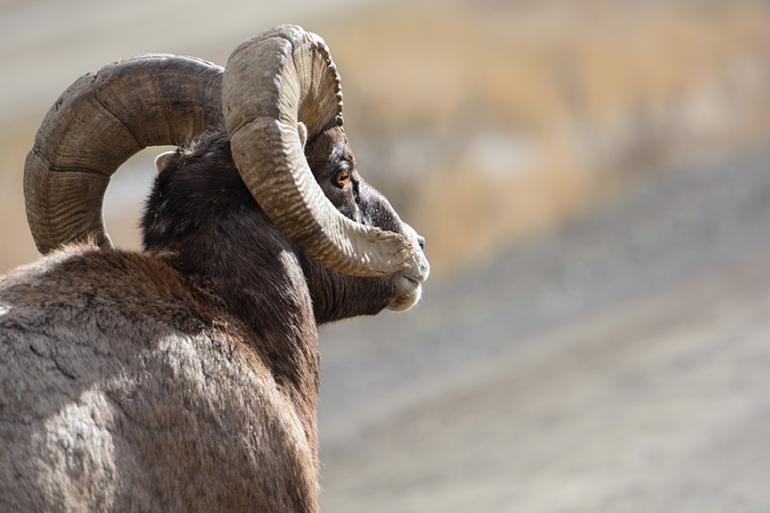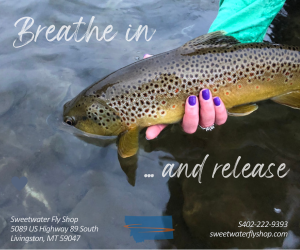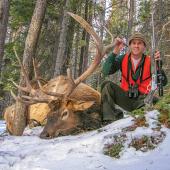Battle of the Bighorns
Like a herd of rutting rams, various parties butt heads over bighorn-sheep management in southwest Montana—but others are figuring out ways to work together.
Great abundance of the Argalia or big-horned animals in the high country through which this river passes. —Meriwether Lewis, May 29, 1805
The “river” in Lewis’s journal entry was central Montana’s Judith, near its confluence with the Missouri. The “Argalia” were Rocky Mountain bighorn sheep, Ovis canadensis. Those Lewis observed in the Missouri Breaks may or may not have represented a distinct subspecies later known as the Audubon sheep (modern DNA evidence suggests otherwise). They were certainly there in “great abundance.” Biologists estimate that more than 100,000 bighorns inhabited what is now Montana when Lewis and Clark arrived. However, by the early 1900s Montana’s bighorn population had plummeted to less than 1,000 animals.
Commercial market hunting and unregulated subsistence hunting certainly played a role in the sheep population’s crash, as did habitat loss and competition with domestic livestock for forage. Nowadays, vehicle collisions add significantly to the annual toll on bighorns. But the greatest cause of wild-sheep mortality once settlers with domestic livestock arrived in the West was disease, particularly epidemic pneumonia. That is still the case today.
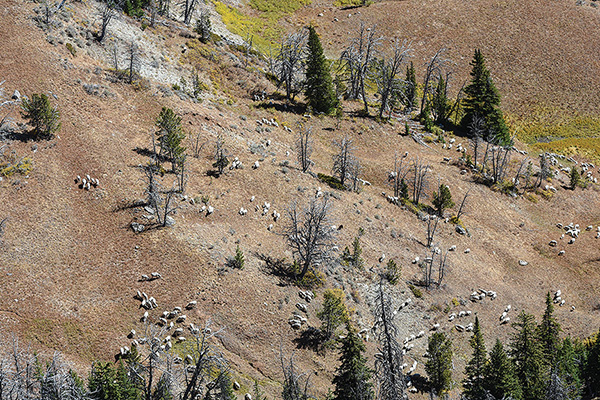
Bighorns & Bugs
“Pneumonia” refers to any infectious disorder of lung tissue. For years, identification of the organism (or organisms) that caused pneumonia in wild sheep remained elusive. While both Pasturella and Mannheimia bacteria are detected in lung tissue from infected sheep, recent studies suggest that the primary culprit is likely a small bacterium called Mycoplasma ovipneumonia (MOVI). Other organisms likely cause secondary infection of damaged lungs.
While the precise mechanisms of the disease are still under study, almost all biologists working on the problem agree that outbreaks of pneumonia in wild sheep are linked to contact with domestic sheep and goats, which commonly harbor MOVI and other suspect pathogens without becoming ill themselves. The disease appears to be highly contagious, requiring minimal contact between wild and domestic sheep. Guidelines from different agencies recommend that wild and domestic sheep be separated by a minimum distance, varying from nine to over 20 miles. Based on a minimum separation distance of 20 miles, a recent study by the National Wildlife Federation (NMF), Montana Wildlife Federation (MWF), and the Bozeman-based Wild Sheep Foundation (WSF) found that 39 of Montana’s 46 wild-sheep herds face potential contact with domestic sheep.
Home to the Gravelly Range
Beginning in the 1940s, the agency that is now Montana’s Department of Fish, Wildlife, and Parks (FWP) began to introduce bighorns to historic wild-sheep habitat from which they had been extirpated. These efforts raised Montana’s current bighorn population numbers to between 5,000 and 6,000 animals. Current FWP management plans call for establishing five new herds per decade to maintain genetic diversity. Because of their history of occupation by wild sheep, habitat quality, and continuity with vast tracts of wilderness, the Gravelly Mountain complex southwest of Bozeman came under consideration as a potential site for introduction. As is so often the case nowadays, social, cultural, and political aspects of this proposal eventually became as complex as the biology.
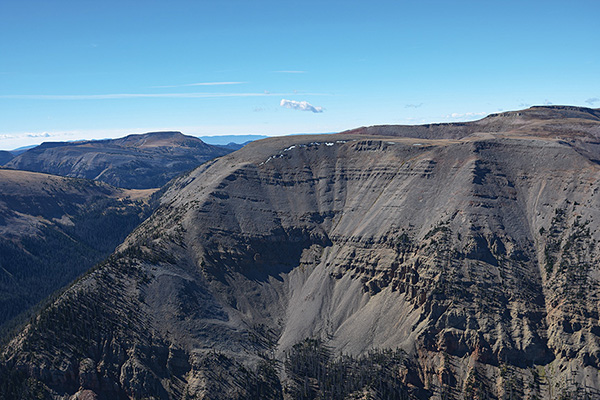 Big Horn Mountain, sans bighorn sheep.
Big Horn Mountain, sans bighorn sheep.
In 2004, FWP released 69 wild sheep in the Greenhorn Mountains. The Greenhorns are part of the Gravelly complex, much of which lies within the Beaverhead-Deerlodge National Forest. Two Dillon-based ranching operations, Helle Livestock and Rebish/Konen Livestock, held Forest Service permits to graze some 8,000 domestic sheep every summer on seven allotments totaling around 55,000 acres in the Gravellys. While those grazing leases lie 15-20 miles away from the introduction site in the Greenhorns, bighorn rams often wander that far in search of ewes. Furthermore, the sheepherders trail their sheep through the Greenhorns to and from their summer pasture.
Because of concerns about potential mingling between wild and domestic sheep, the Forrest Service, Bureau of Land Management (BLM), and FWP signed a memorandum of understanding (MOU) with the grazing-permit holders in 2002, prior to the introduction. This document outlined procedures for dealing with interactions between wild and domestic sheep, including a protocol for prompt notification of FWP staff if wild and domestic sheep were observed in proximity and authorization to lethally dispatch bighorns that came in contact with domestic sheep. Around 15 bighorns were killed under the terms of this MOU between 2004 and 2010, and another 18 were trapped and removed from the area. The MOU also stated that bighorn introduction would not mandate any changes in grazing practices.
Biologists commonly estimate that a minimum of 125 bighorns is necessary to maintain a viable herd. However, this figure is subject to frequent controversy, and many authorities feel it is insufficient to ensure genetic diversity, especially in geographically isolated herds. By 2015 FWP could only identify 48 wild sheep in the Greenhorns. (The biologists performing these surveys emphasize that this is a minimum number, since they likely missed some animals in their survey.)
GWA Goes to Court
Glenn Hockett appeared fit and intense when I met him at his Bozeman home one recent October afternoon, and his passion for wild sheep and their habitat seemed to fill the room. After college in Bozeman and a career as a range manager with the BLM and Forest Service (FS), he now serves as president of the Gallatin Wildlife Association (GWA), a small group of 50-100 members dedicated to the well-being of the area’s wildlife. Since it is an all-volunteer organization, Hockett laughingly admits that his position is not a sound economic model for retirement.
In 2002, the GWA and other groups began asking the FS to update its analysis of potential conflicts between wildlife and domestic livestock in the Beaverhead-Deerlodge National Forest. While policy requires the FS to review wildlife status on grazing allotments every 10 years, one of the seven Gravelly allotment studies had not taken place since 1979 and none was more recent than 2000. According to Hockett, GWA made multiple requests to the FS to update these assessments, but while reviews were scheduled several times, none actually took place.
Finally, GWA (along with two other wildlife groups) filed suit against the FS in June of 2015 to make it follow its own policies. The complaint also contended that the FS had not disclosed the terms of the 2002 MOU, and protested “the United States Forest Service’s failure to protect bighorn sheep and grizzly bears in the Gravelly Mountains of the Beaverhead-Deerlodge National Forest” according to the provisions of the National Environmental Policy Act (NEPA) and the National Forest Management Act (NFMA).
In June of 2016, District Court Judge Brian Morris ruled that the Forest Service “violated its obligations” under NEPA when it failed to disclose the terms of the 2002 MOU, in which the FS agreed not to make any changes to the permit holders’ operations because of bighorn reintroduction. The court also ruled that the agency had not completed sufficient analysis on two of the grazing allotments.
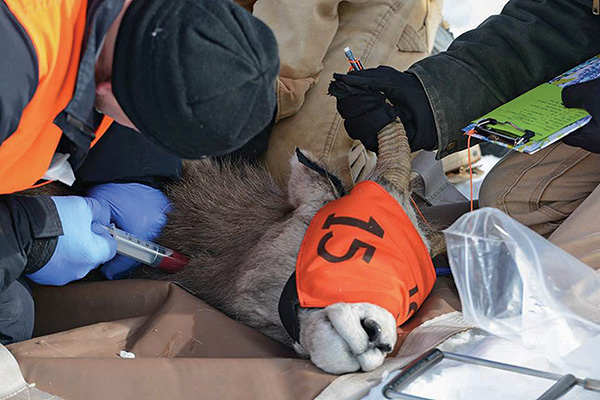
The court did not order grazing to stop while the FS addressed these deficiencies. For now, solutions to the conflict between wild and domestic sheep in the Beaverhead-Deerlodge National Forest lie primarily with the FS. Perhaps inevitably, the court’s ruling did not leave any of the involved parties entirely satisfied.
Toward Common Ground
Like Glenn Hockett, Kurt Ault attended Montana State University and then went on to a career as an FWP biologist. He now works as a staff biologist for the Wild Sheep Foundation (WSF) and its Montana affiliate chapter (MTWSF). A hunter-driven nonprofit, the national organization has been advocating for wild sheep and their habitat since 1977. WSF national headquarters recently completed a move to Bozeman, and I met Ault at their offices there to discuss conflicts in the Gravellys. I found him vigorous and enthusiastic, with a passion for sheep tempered by a willingness to examine all sides of a question and probe for common ground.
I regret that I have not yet met John Helle face to face, although I plan to do so. By email, he has shared some thoughts on the matter from the rancher’s perspective, which is vital to any long-term solution of the conflict between wild and domestic sheep. Based in Dillon, John represents the fourth generation of the Helle family’s operation, which supplies Rambouillet merino to Duckworth Wool. “Caring for the land is our passion,” he notes. Twice every year, the Helles move thousands of sheep some 70 miles from Dillon to summer pasture in the high country and back, as if replaying a chapter of Montana history from the territorial days. He clearly harbors resentment about the lawsuit, regretting that, “It pits us against wildlife advocates.”
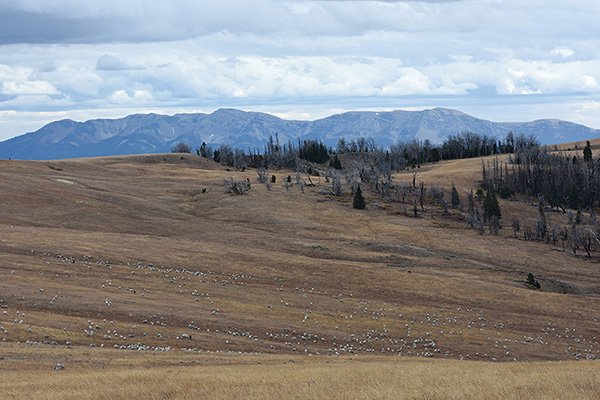
Meet the flockers: smart wool or myopic management?
By the time Judge Morris issued his ruling, Ault, Helle, and the interests they represent had tried to resolve their differences. In March of 2016, members of the MTWSF and the Montana Wool Growers Association (MWGA) met in Choteau to discuss “mutual interests in enhancing Montana’s bighorn sheep population, while protecting Montana’s existing agricultural operations.” The resulting two-page letter, signed by both parties, certainly made some valid points, citing the benefits of cooperation, the need to keep wild and domestic sheep separated in space and time, frustration with a polarized state legislature, and the importance of using best available science to guide future decisions.
The document is short on specifics, however, save for predictable concern about predators, a call for increased research funding, and the formation of a working group including all stakeholders. The document includes three critical references to litigation that seem rather directly pointed at the lawsuit filed by the GWA. When I noted this in my discussion with Glenn Hockett, he replied that, “Our argument is with the Forest Service, for failing to do their job as their own policy requires.”
Despite these shortcomings, given the historic antipathy between ranching interests and wild-sheep advocacy groups like MTWSF, this memorandum is an encouraging sign. The issue of bighorns in the Gravelly landscape derives much of its complexity from the number and diversity of the stakeholders. That list includes the FS, GWA, WSF, BLM, FWP, and NWF as well as hunters, woolgrowers, and the general public. Some of these groups include members in common, while others represent deeply polarized interests. Since two mutually exclusive poles—no domestic sheep in the Gravellys, or no wild sheep in the Gravellys—define the spectrum of opinion, finding common ground appears a difficult task. In our era of dysfunctional polarization, it is difficult to criticize opposing groups willing to sit down and try to reconcile their differences amicably.
Unfortunately, it will take more than goodwill to solve difficult questions about the future of wild sheep in the Gravellys with anything short of “one or the other.” And as Glenn Hockett asks, “If Montanans can’t have bighorns on Big Horn Mountain (a peak in the Gravelly Range), where can we have them?”
Bighorns in the Future
I don’t have a dog in this fight, although it might be more accurate to say I have a dog in every corner. As a hunter, I have a stake in Montana’s wild sheep (even though I haven’t drawn a Montana bighorn tag after trying for over 40 years). As a naturalist, photographer, and—yes—an “environmentalist,” my stake may be even greater. But my ancestors were Texas ranchers, and my wife, Lori—a fourth generation Montanan—comes from a family that raised sheep on the Eastern Front. Regular readers know that I don’t hesitate to cry foul when prodded (see Outside Bozeman, Fall 2015), but I feel no personal disregard for anyone involved in this controversy.
Faced with such a dilemma, it helps to begin with principles upon which all (well, almost all) parties agree, in this case:
1. Bighorn sheep are iconic Western animals that deserve to thrive in Montana.
2. Family ranching is an essential element of Montana’s economy and culture.
3. Wild and domestic sheep cannot occupy the same place in space and time without unacceptable disease risk to bighorns.
4. All agencies involved in wild-sheep management need appropriate policies based on the best science—and they need to follow them.
Finding solutions won’t be easy. Fencing won’t solve the problem; you can’t fence out bacteria. Domestic sheep could be removed from the Gravellys, by fiat or, preferably, by negotiation. The NWF and other groups have addressed similar problems in other areas by buying back grazing leases in critical wildlife habitat. This approach deserves future consideration.
Perhaps science will someday end the gridlock. Not all domestic sheep carry the organisms implicated in epidemic pneumonia, and not all wild-sheep herds succumb following exposure. Precise identification of the factors responsible for those anomalies could produce major breakthroughs. The WSF and other groups are actively pursuing funding for such research, and Bozeman’s Montana State University could provide an ideal venue for it. Kurt Ault showed me a hopeful statement from Washington State University’s Dr. Thomas Besser: “Elimination of MOVI would reduce the risk of epidemic pneumonia in bighorn sheep by 90% or more.” Maybe someday Montana will have certified MOVI-free sheep to go along with our brucellosis-free cattle.
For now, Montanans will have to make difficult choices about what kind of sheep they want in the Gravellys. The matter has likely not had its last day in court no matter how any of the parties feel about litigation. Ranching interests clearly resent it, and Glenn Hockett of the GWA states “We don’t look at lawsuits as the first thing, but the last.” However, Hockett also feels that “The courts give the little guy and the general public a vital role in wildlife management.”
Healthy, viable herds of bighorns grazing in suitable habitat throughout the state would be wonderful for Montana. Unfortunately, for now the road to that goal remains as rocky as the places wild sheep live.


